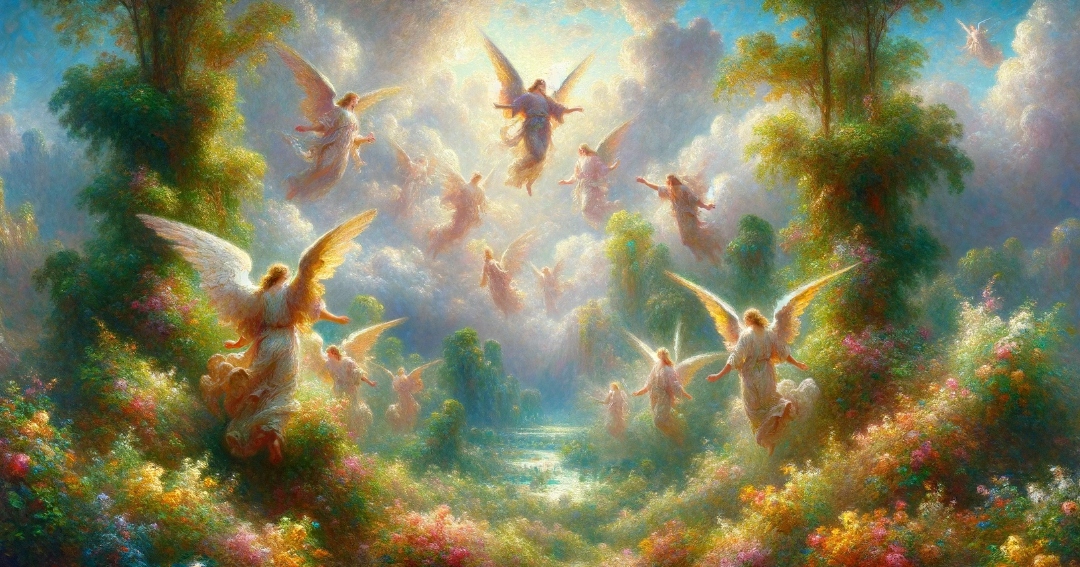The Bible mentions different types of angels, including archangels, cherubs, and seraphs. These angels held different positions, so what are the types of biblical angels and their hierarchy?
Angels in the Bible: Table of Contents
Hierarchy of Angels
The hierarchy of angels in the Bible is not as explicitly detailed as later Christian theological sources like those of Pseudo-Dionysius the Areopagite or later medieval scholars. However, there are several types of angels mentioned in the Bible, which indicate a variety of roles and ranks within the heavenly host. Here are the primary types of angels and their roles as described in the Bible:
1. Seraphim. Reference: Isaiah 6:1-7
Description: Seraphim are depicted as having six wings: with two they cover their faces, with two they cover their feet, and with two they fly. They stand above God as He sits on His throne, continuously singing praises ("Holy, holy, holy is the LORD Almighty; the whole earth is full of his glory").
2. Cherubim. References: Genesis 3:24; Ezekiel 10
Description: Cherubim guard the way to the Tree of Life in the Garden of Eden and are depicted in Ezekiel as having four faces (that of a lion, an ox, a human, and an eagle), and they are tasked with the protection of God's divine glory. They also appear in the architectural and decorative arts of the Temple as described in Exodus and Kings.
3. Archangels. Reference: Jude 1:9; 1 Thessalonians 4:16
Description: Archangels like Michael, who is mentioned by name, are often seen as leaders among the angels. Michael is described as contending with the devil and as playing a significant role in end-times events. Raphael and Gabriel are also traditionally considered archangels, though Gabriel is not explicitly called an archangel in the Bible.
4. Angels. References: Throughout the Old and New Testaments
Description: Angels are the most frequently mentioned heavenly beings in the Bible. They act as messengers of God, serve as protectors and guides for humans, and carry out God’s judgments. Angels appeared to figures such as Abraham, Jacob, and Mary, delivering God’s messages and guidance.
Other Heavenly Beings
Living Creatures (often associated with Cherubim): These appear in the visions of Ezekiel and the Revelation to John, where they are described as full of eyes in front and behind, with each of the four living creatures having a different face.
Principalities, Powers, Thrones, Dominions: Mentioned in the writings of Paul (e.g., Romans 8:38, Colossians 1:16), these terms suggest a variety of ranks or classes of angels, though their exact nature and roles are not as delineated as they are in later Christian theology.
In Christian theology, particularly from the 4th century onward, more elaborate systems of angelic hierarchy emerged, heavily influenced by non-Biblical writings. Pseudo-Dionysius the Areopagite’s "Celestial Hierarchy" is a key work that expanded on these ideas, grouping angels into three hierarchies and nine orders. This more detailed hierarchy has influenced much of Christian angelology but is not explicitly found in the scriptural texts.
Types of Angels in the Bible
Scripture introduces us to several different types of angels.
Cherubim
In Genesis, we are introduced to cherubim set to guard the entrance to the Garden of Eden (Genesis 3:24) stationed at the east of the Garden of Eden to guard the way to the Tree of Life with a flaming sword, symbolizing their role as protectors of sacred spaces and divine secrets. In Exodus, Cherubim (singular cherub) are described as creatures with two wings. An article from MyJewishLearning.com compares “the Hebrew word keruv (“cherub”) to the Aramaic expression ke revaya meaning “like a child” (according to a statement of Rabbi Abahu in Sukkah 5b).” This is thought to be the reason cherubim are often depicted in art as ‘baby’ angels. But even in rabbinical communities, people debate the idea since Ezekiel 10:14 depicts cherubim as having the face of a man.
Most scholars agree that the cherubim’s role is guarding things that are holy both in heaven and on earth. Many of the decorative elements of both the early Tabernacle and Solomon’s Temple included images of cherubim.
Regarding appearance, cherubim are often depicted with multiple wings and faces, representing different aspects of creation. For example, in the vision of Ezekiel, cherubim have four faces – that of a human, a lion, an ox, and an eagle – and four wings, symbolizing their all-encompassing nature and their connection to all living beings.
Seraphim
Another type of angel mentioned is a Seraph or Seraphim. These types of angels are found in Isaiah 6. Isaiah describes what these angels look like in verse two, “Seraphs stood over him; each one had six wings. With two wings they covered their faces, with two they covered their feet, and they used the remaining two to fly.” They must have been an odd sight to see for Isaiah’s eyes.
As described in Isaiah's vision, the seraphim's primary role is to worship and praise God continuously. They are heard chanting, "Holy, holy, holy is the Lord of hosts; the whole earth is full of his glory." This chant emphasizes the holiness and omnipresence of God. The seraphim are also involved in a purification ritual for Isaiah, as one of them takes a live coal from the altar and touches it to Isaiah's lips, symbolically cleansing him of his sins and preparing him for his prophetic mission. This act highlights the seraphim's role in facilitating the interaction between the divine and the human, serving as a bridge between God's holiness and humanity's imperfection.
Archangels
Archangels are a prominent and well-known category of angels in the Bible, recognized for their significant roles. They are often tasked with delivering important messages from God to humans and carrying out other divine missions.
The term archangel makes two appearances in Scripture in 1 Thessalonians 4:16 and Jude 9.
Guardian Angels
In Psalm 91:11 and Matthew 18:10, angels referred to as guardian angels are mentioned.
Contributor Whitney Hopler also states, “The Bible also tells us that some angels have fallen from the glorious way that God had originally designed them to be. While most angels remained holy and faithful to God (Revelation 5:11-12), some angels became corrupted by sin after participating in a rebellion led by one angel. That angel, known as Lucifer before the angelic fall and as Satan afterward, fell from heaven after trying to take God’s power for himself (Isaiah 14:12-14).
The angels mentioned in Scripture are found in Genesis 16, attending Hagar and telling Sarah of Isaac, then again in Genesis 18, when Abraham is visited by three men, one of which is later in Genesis 18:22, is identified as “the LORD.” This is often referred to as a theophany, an appearance of God to humans, usually considered Jesus before the incarnation.
The other two ‘men’ are sent to Sodom to carry out judgment and are referred to as angels in Genesis 19:1. In Genesis 16 and 19, these “men” are referred to as angels but are given no other physical qualities or titles.

Duties of Angels in the Bible
From Scripture and extra-biblical texts, each type of angel seems to have a different role or function among the heavenly host.
Messengers: One of the primary roles of angels is to act as messengers of God. They deliver important messages or revelations to people throughout Scripture. For example, when the angel Gabriel announced the births of John the Baptist and Jesus to Zechariah and Mary, respectively (Luke 1:11-38).
Angels act as intermediaries between God and humans, facilitating communication and the execution of God's will. They also intercede on behalf of humans, as seen in the story of Abraham pleading for Sodom and Gomorrah (Genesis 18:22-33).
Warriors: Angels are also depicted as warriors in spiritual battles. The archangel Michael is often associated with this role, as he is described as leading the heavenly army against Satan and his forces (Revelation 12:7-9). Archangels in Scripture are the ones in a battle for God.
Worshippers: Angels continuously worship and praise God in the heavenly realm. The seraphim in Isaiah's vision constantly proclaim God's holiness, saying, "Holy, holy, holy is the Lord of hosts; the whole earth is full of his glory" (Isaiah 6:3).
Protectors: Cherubim are often set as guards within Scripture. God places cherubim at the entrance to the Garden of Eden, and depictions of cherubim are used throughout the Tabernacle and Solomon’s temple. As well as being near God’s throne in Revelations.
Guides: in the Book of Exodus, an angel is said to lead the Israelites through the wilderness (Exodus 23:20). Additionally, the concept of guardian angels suggests that individuals have angels assigned to watch over and protect them (Psalm 91:11).
Guardian angels, mentioned in Psalm 91:11 and by Jesus in Matthew 18:10, are said to protect and aid the saints in their prayers.
Names of Angels in the Bible
Michael is named an archangel in Jude verse 9 and makes other appearances in Daniel 10, fighting a Persian king, and in Revelations 12:7, fighting against Satan with an army of angels.
Gabriel is another named angel that spoke with Zechariah, announcing John the Baptist’s birth. Then also to both Mary and Joseph concerning the birth and protection of Jesus. Gabriel makes an earlier appearance in a vision given to Daniel in Daniel 8:16 and Daniel 9:20. Some apocryphal books call Gabriel an archangel because he is given a name. Still, in canonical Scripture, Michael is the only named archangel. So, we don’t know Gabriel’s place in the angel hierarchy. But what is known is his role. Gabriel is a messenger of God sent to give direction and clarity to what God is doing.
The Bible text doesn’t list any other named angels. But in extra-biblical text, other angels are named. Raphael (Tobit 12:15-22) is considered an archangel who serves God in healing acts. Uriel (2 Esdras 4:1-8) gives wisdom to those growing in their relationship with the Lord. In an article on Archangels, Hope Bolinger also lists, “Jophiel: From Jewish and Kabbalistic lore, she is linked often with beauty and positivity. No Scripture or extracanonical text seems to mention her by name.”
Exodus 11-12 introduces us to the Angel of Death in the tenth plague. This angel of death is a common figure throughout history and has even been personified as the Grim Reaper with a black cloak and scythe to gather souls at the time of death. While the canonical and extra-biblical text does not give the angel a name, there is some archeological evidence as well as references in the Islamic text (Surah 32:11) and Jewish folklore to the angel of death being given the name Azrael or Ezra’el. In some Talmudic texts, the angel of death is also given the name Samael.
One name that many believe is a named angel in Scripture is Lucifer. Bible teacher Joseph M. Jordan says, “The name ‘Lucifer’ is not explicitly mentioned in most translations of the Bible. Still, the concept of a fallen angel or Satan is present, with the closest reference to “Lucifer” being found in Isaiah 14:12, where the Hebrew phrase “Helel ben Shachar” is used, which means “morning star, son of the dawn.” This phrase is sometimes translated to “Lucifer” in Latin translations of the Bible. However, there’s debate among scholars about whether this passage is referring to Satan or a Babylonian king.”
How Angels Reveal God's Nature
Angels are fascinating creations that have taken on a whole mythology unto themselves. But when they appear in Scripture, it is a moment that communicates that God is starting a divine action. They give us a peek into the heavenly realms we cannot see or completely understand, which is why they appear predominately in art and fiction. But what do different types of angels tell us about God?
Angels show us that God is creative. Though we are given only a few details about what some angels look like, they are creatures that stretch our human understanding. When you read Revelations 4: 6-9 and see the four bizarre creatures around the throne of God, there can be no doubt of the infinite creativity of God.
Angels and the actions of angels in the Bible also show us that God values his creations. All the different types of angels show us that God loves diversity. All his creations, heavenly and earthy creatures, have value and purpose.
When angels appear in Scripture, God is either seeking to protect his people or moving toward salvation in Jesus Christ that will return us to a right relationship with God.
Finally, they show us that order is important to God. The fact that angels have jobs, hierarchy, and purpose shows us that God seeks order, not chaos. Even in heaven, there is an order that shows us that God is more than a kid watching an ant farm. Jobs and purpose suggest a mission and a goal all are moving toward. A company’s CEO seeks the best for the company regarding its mission statement. And gives goals and tasks to their employees toward this goal. The same is true of God and his heavenly hosts. All are on a mission toward redeeming the world and the people God loves. We can join this mission with the gift of the Holy Spirit through salvation in Christ Jesus.
Photo Credit: © Getty Images/bestdesigns

You can find out more about Valerie, her books, and her blog at www.valeriefentress.com.
This article is part of our Bible resource for understanding the significance and meaning of biblical phrases and ideas. Here are our most popular Bible articles to grow in your knowledge of God's Word:
Promises of God in the Bible
Is "This Too Shall Pass" in the Bible?
What Was the Ark of the Covenant?
Top 10 Bible Stories for Kids
“Iron Sharpens Iron” in Proverbs 27:17
"Fearfully and Wonderfully Made" in Psalm 139
“Be Still and Know That I am God” in Psalm 46:10
"No Weapon Formed Against Me Shall Prosper" - Isaiah 54:17


.jpg)
